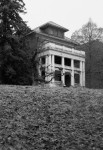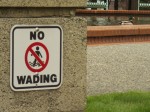May
31
2014

I was fortunate to be included in issue number two of Latent Image magazine a great showcase of photographic talent. I know, I know so what are my pictures doing in it you ask? I’m not sure I just take pictures but what I do know is that it is a great magazine from cover to cover. Here is a snippet of my two pages and yes I am using tarps in these images as a metaphor for the obscuring of the truth.

2 comments | posted in Art observations, Photography
May
29
2014

There is plenty of information available about the Canon AE-1 so I won’t spend too much valuable photography time writing about it but I will say that it leaves something to be desired in terms of ease of use. My primary complaint being the lack of any feedback in the viewfinder (in manual mode) as to what the camera is set to. Also the lack of exposure compensation beyond a hard to locate +1.5 EV backlight compensation button make it less versatile than other similar SLR’s from that time even a basic Pentax K1000 using metered manual is easier.
Used in shutter priority mode which is really its native setting it’s fine and the viewfinder is big and bright. There are many FD lenses available with the 50mm 1.4 being a great example and reason enough to shoot with this camera if you are willing to take the time to adjust to it’s controls.
no comments | tags: Canon, film | posted in Cameras, Photography
May
25
2014

They really aren’t kidding with this film when they say handle in subdued light. I thought that for the most part I had been careful yet the film ended up being heavily light struck. All indications are that the light came in through where the film exits the canister so none of this would have been while the film was in the camera. What makes this film unique is that it doesn’t have the usual orange dye masking of nearly all other c41 colour negative films. This is supposed to make it easy to scan and more versatile in different lighting. Unfortunately for me the light leak over rides any other factor of this film. That being said even those images struck by light have a certain look that makes them unique and clearly sets them apart as being from film.

I shot this roll of film in my trusty Yashica Electro GT


no comments | tags: Cameras, film, Photography | posted in Cameras, Composition, Photography
May
22
2014

The Holga TIM is an interesting camera that lends itself to photographic experimentation. With its two lenses that can be covered and uncovered independently and the fact that the shutter can be reset without advancing the film it allows you to shoot two images side by side within the space of a regular 35mm film frame. You can also do multiple exposures on a single frame using the shutter reset. For these images though I would expose one lens at a time and then reset the shutter and exchange which lens was uncovered, producing diptychs on film.
2 comments | tags: film, holga | posted in Cameras, Photography, Uncategorized
May
20
2014
It’s all been seen before as the saying goes. I want to back up for a minute though. In 2013 I was driving south on the Trans Canada Hwy through the Thompson Canyon. I am always looking for things to photograph but in this case my desire to pull over was additionally fueled only in the way that too much coffee and hours of driving can. At a certain point I saw a foot bridge over the river that I had never noticed before and doubled back to see if I could have a closer look. I made my way down to the footings of the bridge which was completed locked against any entry but I knew I had to photograph it. I took a few pictures and was quite pleased but what I really wanted was a train with tanker cars across the river. I didn’t need to wait long. I took a few shots to get things set up and waited for the right moment when the tankers were in the frame. I included the river in the composition as I was trying to show in one image the precarious situation of oil filled rail cars on the edge of one of the most important rivers in British Columbia.

Thompson River with tanker cars, 2013 (Wallace Koopmans)
Fast forward to May 2014 when I went to the Vancouver Art Gallery. I reached the second floor with the Edward Burtynsky exhibit and I was only three images in when I was confronted with the large-scale print (Railcuts #11 CN Track Thompson River, British Columbia 1985)

I knew immediately that this was the same location that I had been at the previous summer. Now I was aware of Burtynsky’s series ‘Railcuts’ and had seen several examples but I don’t believe I had ever seen this image. That doesn’t really matter though because I am clearly influenced by his work. Looking at the printed image the amount of detail he captured was amazing far beyond what I recorded with my piddly 35mm camera.
I enjoyed the rest of the exhibit and noticed several things about his work. In his more resent images he has a greater degree of abstraction with less of a sense of depth and an often higher vantage point. The difference this makes is that with some works if you stand at a certain distance they give a feeling of looking through a window right into the scene, that effect doesn’t happen with the aerial shots. If you are unfamiliar with Edward Burtynskys work I encourage you to take any opportunity to see one of his prints that you can, failing that check out one of his books, an image on a screen will not do them justice.
no comments | tags: film, Photography | posted in Art observations, Photography
May
17
2014
1 comment | tags: iPad, Painting | posted in Painting
May
16
2014

I shot an entire roll of film through my Olympus OM1…twice. It was on purpose of course and I took quite a bit of care in lining the film up for the second go around. I achieved this by making a small scratch on the film so that I could align it the same both times. This actually was harder than it sounds as each time you start loading the film it’s like some sort of random position generator. The first exposures were all of various line art from old technical books and some of my own block prints. What I discovered was that such small areas of high contrast like this were not ideal for double exposures. Many of the line art images are lost in the other second images. However that is how you learn and improve. I added a further layer of complexity to my endeavor by making a list of all the images and then trying to make some sort of match between the two. Here are some of the better examples from this test, in the future I think I would make sure that I used larger areas of dark and light so it makes more of a cut out effect of the second image. The other thing is that despite the visual contrast of black on the white of paper this isn’t nearly enough contrast. Not like what you get from a light source and a silhouette.
1 comment | tags: camera, film, olympus | posted in Photography, Processing
May
12
2014

In the image above the lenses on the right side are all homebrew lenses I made for the Pentax Q. I purchased three Q mount to C mount adapters, took them apart and used only the part that mounts to the camera. The lenses themselves are a 12mm pancake distortion creator a 35mm f2.8 and the newest one a 40mm f1.9 from a Canon AF35ML which is currently set to a fixed focus point and aperture and works like a macro lens. They are of course manual focus and with the conversion factor the 40mm has a field of view similar to a 220mm lens on a ‘full frame’ sensor or 35mm film. Each one of these lenses has limitations in the quality of the image they produce but are a fun way of experimenting.
no comments | tags: Digital, lenses, Pentax | posted in Cameras, Photography
May
10
2014
This is the start of a series of digital paintings based on Google street views.
The way we interact helps to define us as humans. These interactions can be fleeting and no more so than those captured by chance. I wanted to separate the final images from being simple screen captures and so have recreated them as digital paintings on my iPad. I hope with this context the images will speak for themselves.

3 comments | tags: Digital, iPad, Painting | posted in Painting





















































































